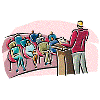Department of Teaching, Learning, and Teacher Education

Department of Teaching, Learning, and Teacher Education: Presentations
Date of this Version
2010
Document Type
Article
Citation
Paper presented at the annual meeting of the National Association for Research in Science Teaching: Philadelphia, PA.
Abstract
Three-hundred-and-twenty-three classroom observations of secondary science and language arts teachers were made over two academic years while teachers engaged in professional development (PD) in how to construct scientific classroom discourse communities. These observations were used, along with teacher demographic information, to build a hierarchical linear model to explore statistical relationships. The length of time that teachers received PD was chosen as the exclusive predictor of teacher change while a schools’ percentage of students who qualified for free and reduced lunch (a proxy for SES) was chosen as the exclusive predictor of intercepts. Over the course of two years, the teachers who had participated for longer periods of time used more of the PD, that is, they had higher rates of change than newly participating teachers. The model indicated, with statistical significance, that SES predicted teachers' baseline levels of behavior associated with the PD they were yet to receive. However, with respect to teachers’ change over time, only the amount of PD that a teacher received or their treatment group membership predicted use with statistical significance. Ergo, while teachers' students' SES was important in determining where teachers began, the treatment itself accounted for how teachers’ instructional practices changed over time.


Comments
Copyright (c) 2010 Elizabeth Lewis, Dale Baker, Nievita Bueno Watts, Brandon Helding, & Michael Lang.